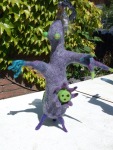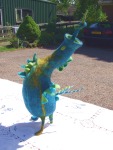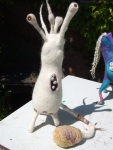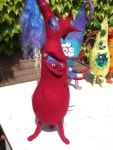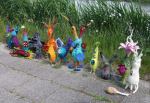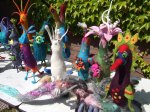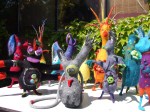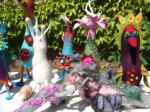How long can barnacles live out of water? The answer, I fear, may be longer than you think. More on this in a minute.
While I was at the pods workshop with Andrea Graham, I managed to finish one pod and start another. However, due to the pressures of work since I got back, I’ve only just got round to completing this second one.
This pod was intended to be another sample, trying to incorporate or improve some of the techniques I’d learned. One of these was embedding an object like a bead or a marble. I decided to try using a cluster of barnacle shells I’d found on a beach several years ago. (You can see where this is going!)
I don’t know exactly how long I’ve had this barnacle cluster, but it’s definitely a few years. I’m a city girl through and through, but when I’m on the coast I do love beachcombing, gathering shells, pebbles and other items that ESP regards as luggage-loading detritus. The barnacles have been sitting in a glass jar along with a random collection of other shells and bits of dead coral, waiting for the right project to come along. And this time I thought it had.
The shells looked perfectly innocuous, so I placed the cluster on top of my pod, put a plastic resist on top, and enclosed it in a nice coat of merino.

Then I wet felted it.
When I opened up the resist, the cluster looked different. Some of the shell plates inside the craters, which had been firmly shut when dry, now looked partly open. And there was a bit of a whiff of the sea.

There was nothing for it but to remove the cluster and extract what remained of the barnacles from their shells (I have to say that a felting needle is very good for this!). Then, after thoroughly disinfecting the rest (along with the felting needle!) I eased the cluster gently back in.
[Short digression here – please ignore if you are not interested in barnacle anatomy!]
I had assumed that barnacles were molluscs, but actually they are crustaceans. The diagram below shows how it resembles a shrimp lying on its back, with leg-like appendages that the barnacle uses to absorb oxygen and waft plankton into the mouth.

It also has a pretty long penis!
Ahem. As to the question of how long barnacles can live outside water, I could find no definitive answer. This article claims that one species can live for three years “with only brief submergence one or two days a month” – which my barnacles never received.
I only hope that the creatures were dead and that the opening of the shell plate in response to water was just a reflex action.
[/end digression]
Anyway, here is the sanitised end result. It’s a bit top heavy I think, but, as ever, it was a useful learning experience, in more ways than one. 🙂



Maybe I should just stick to plain ol’ felt barnacles.













